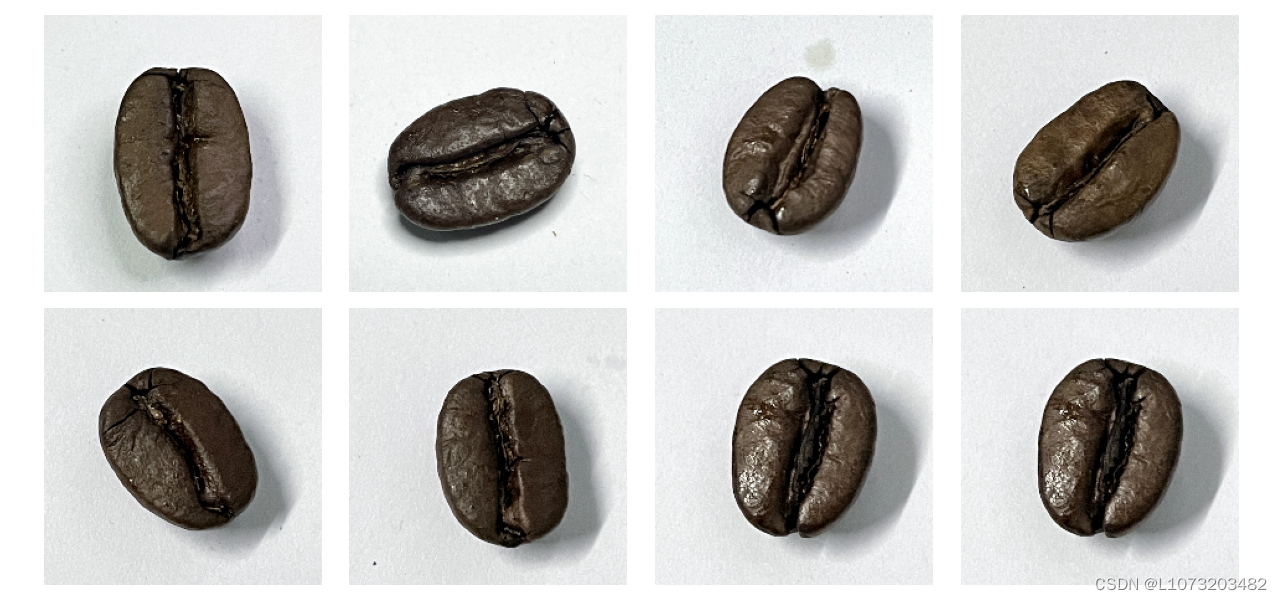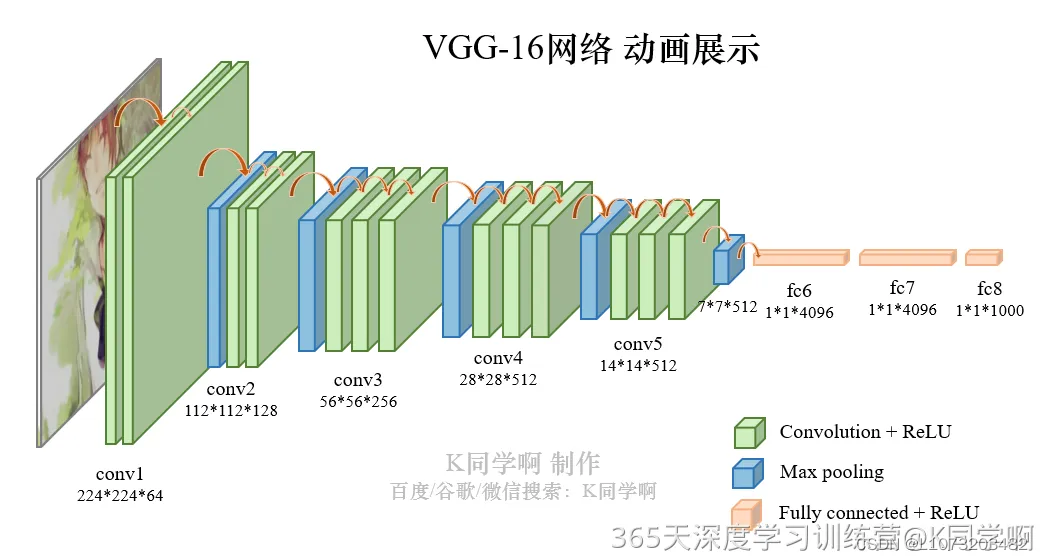- 🍨 本文为🔗365天深度学习训练营 中的学习记录博客
- 🍖 原作者:K同学啊 | 接辅导、项目定制
一、我的环境:
1.语言环境:Python 3.9
2.编译器:Pycharm
3.深度学习环境:
- torch==2.1.2+cu118
- torchvision==0.16.2+cu118
二、GPU设置:
import torch
device = torch.device("cuda" if torch.cuda.is_available() else "cpu")
print(device)三、导入数据:
- pathlib.Path函数将字符串类型的文件夹路径转换为pathlib.Path对象。
- glob()方法获取data_dir路径下的所有文件路径,并以列表形式存储在data_paths中。
- split()函数对data_paths中的每个文件路径执行分割操作,获得各个文件所属的类别名称,并存储在classeNames中。
- 打印classeNames列表,显示每个文件所属的类别名称
import os,PIL,random,pathlib
data_dir = './data/'
data_dir = pathlib.Path(data_dir)
data_paths = list(data_dir.glob('*'))
classeNames = [str(path).split("\\")[1] for path in data_paths]
print(classeNames)运行结果:
['Dark', 'Green', 'Light', 'Medium']四、数据可视化:
# 指定图像文件夹路径
image_folder = './data/Dark'
# 获取文件夹中的所有图像文件
image_files = [f for f in os.listdir(image_folder) if f.endswith((".jpg", ".png", ".jpeg"))]
# 创建Matplotlib图像
fig, axes = plt.subplots(2, 4, figsize=(16, 6))
# 使用列表推导式加载和显示图像
for ax, img_file in zip(axes.flat, image_files):
img_path = os.path.join(image_folder, img_file)
img = Image.open(img_path)
ax.imshow(img)
ax.axis('off')
# 显示图像
plt.tight_layout()
plt.show()运行结果:

五、划分数据集
# 关于transforms.Compose的更多介绍可以参考:https://blog.csdn.net/qq_38251616/article/details/124878863
train_transforms = transforms.Compose([
transforms.Resize([224, 224]), # 将输入图片resize成统一尺寸
# transforms.RandomHorizontalFlip(), # 随机水平翻转
transforms.ToTensor(), # 将PIL Image或numpy.ndarray转换为tensor,并归一化到[0,1]之间
transforms.Normalize( # 标准化处理-->转换为标准正太分布(高斯分布),使模型更容易收敛
mean=[0.485, 0.456, 0.406],
std=[0.229, 0.224, 0.225]) # 其中 mean=[0.485,0.456,0.406]与std=[0.229,0.224,0.225] 从数据集中随机抽样计算得到的。
])
total_data = datasets.ImageFolder("./data/",transform=train_transforms)
print(total_data)batch_size = 32
train_dl = torch.utils.data.DataLoader(train_dataset,
batch_size=batch_size,
shuffle=True,
num_workers=1)
test_dl = torch.utils.data.DataLoader(test_dataset,
batch_size=batch_size,
shuffle=True,
num_workers=1)for X, y in test_dl:
print("Shape of X [N, C, H, W]: ", X.shape)
print("Shape of y: ", y.shape, y.dtype)
break运行结果:
Shape of X [N, C, H, W]: torch.Size([32, 3, 224, 224])
Shape of y: torch.Size([32]) torch.int64六、手动搭建VGG-16模型
VGG-16(Visual Geometry Group-16)是由牛津大学视觉几何组(Visual Geometry Group)提出的一种深度卷积神经网络架构,用于图像分类和对象识别任务。VGG-16在2014年被提出,是VGG系列中的一种。VGG-16之所以备受关注,是因为它在ImageNet图像识别竞赛中取得了很好的成绩,展示了其在大规模图像识别任务中的有效性。
- 深度:VGG-16由16个卷积层和3个全连接层组成,因此具有相对较深的网络结构。这种深度有助于网络学习到更加抽象和复杂的特征
- 卷积层的设计:VGG-16的卷积层全部采用
3x3的卷积核和步长为1的卷积操作,同时在卷积层之后都接有ReLU激活函数。这种设计的好处在于,通过堆叠多个较小的卷积核,可以提高网络的非线性建模能力,同时减少了参数数量,从而降低了过拟合的风险- 池化层:在卷积层之后,VGG-16使用最大池化层来减少特征图的空间尺寸,帮助提取更加显著的特征并减少计算量
- 全连接层:VGG-16在卷积层之后接有3个全连接层,最后一个全连接层输出与类别数相对应的向量,用于进行分类
网络结构图:

import torch.nn.functional as F
class vgg16(nn.Module):
def __init__(self):
super(vgg16, self).__init__()
# 卷积块1
self.block1 = nn.Sequential(
nn.Conv2d(3, 64, kernel_size=(3, 3), stride=(1, 1), padding=(1, 1)),
nn.ReLU(),
nn.Conv2d(64, 64, kernel_size=(3, 3), stride=(1, 1), padding=(1, 1)),
nn.ReLU(),
nn.MaxPool2d(kernel_size=(2, 2), stride=(2, 2))
)
# 卷积块2
self.block2 = nn.Sequential(
nn.Conv2d(64, 128, kernel_size=(3, 3), stride=(1, 1), padding=(1, 1)),
nn.ReLU(),
nn.Conv2d(128, 128, kernel_size=(3, 3), stride=(1, 1), padding=(1, 1)),
nn.ReLU(),
nn.MaxPool2d(kernel_size=(2, 2), stride=(2, 2))
)
# 卷积块3
self.block3 = nn.Sequential(
nn.Conv2d(128, 256, kernel_size=(3, 3), stride=(1, 1), padding=(1, 1)),
nn.ReLU(),
nn.Conv2d(256, 256, kernel_size=(3, 3), stride=(1, 1), padding=(1, 1)),
nn.ReLU(),
nn.Conv2d(256, 256, kernel_size=(3, 3), stride=(1, 1), padding=(1, 1)),
nn.ReLU(),
nn.MaxPool2d(kernel_size=(2, 2), stride=(2, 2))
)
# 卷积块4
self.block4 = nn.Sequential(
nn.Conv2d(256, 512, kernel_size=(3, 3), stride=(1, 1), padding=(1, 1)),
nn.ReLU(),
nn.Conv2d(512, 512, kernel_size=(3, 3), stride=(1, 1), padding=(1, 1)),
nn.ReLU(),
nn.Conv2d(512, 512, kernel_size=(3, 3), stride=(1, 1), padding=(1, 1)),
nn.ReLU(),
nn.MaxPool2d(kernel_size=(2, 2), stride=(2, 2))
)
# 卷积块5
self.block5 = nn.Sequential(
nn.Conv2d(512, 512, kernel_size=(3, 3), stride=(1, 1), padding=(1, 1)),
nn.ReLU(),
nn.Conv2d(512, 512, kernel_size=(3, 3), stride=(1, 1), padding=(1, 1)),
nn.ReLU(),
nn.Conv2d(512, 512, kernel_size=(3, 3), stride=(1, 1), padding=(1, 1)),
nn.ReLU(),
nn.MaxPool2d(kernel_size=(2, 2), stride=(2, 2))
)
# 全连接网络层,用于分类
self.classifier = nn.Sequential(
nn.Linear(in_features=512*7*7, out_features=4096),
nn.ReLU(),
nn.Linear(in_features=4096, out_features=4096),
nn.ReLU(),
nn.Linear(in_features=4096, out_features=4)
)
def forward(self, x):
x = self.block1(x)
x = self.block2(x)
x = self.block3(x)
x = self.block4(x)
x = self.block5(x)
x = torch.flatten(x, start_dim=1)
x = self.classifier(x)
return x
加载并打印模型
import torchsummary as summary
model = vgg16().to(device)
summary.summary(model, (3, 224, 224))运行结果:
----------------------------------------------------------------
Layer (type) Output Shape Param #
================================================================
Conv2d-1 [-1, 64, 224, 224] 1,792
ReLU-2 [-1, 64, 224, 224] 0
Conv2d-3 [-1, 64, 224, 224] 36,928
ReLU-4 [-1, 64, 224, 224] 0
MaxPool2d-5 [-1, 64, 112, 112] 0
Conv2d-6 [-1, 128, 112, 112] 73,856
ReLU-7 [-1, 128, 112, 112] 0
Conv2d-8 [-1, 128, 112, 112] 147,584
ReLU-9 [-1, 128, 112, 112] 0
MaxPool2d-10 [-1, 128, 56, 56] 0
Conv2d-11 [-1, 256, 56, 56] 295,168
ReLU-12 [-1, 256, 56, 56] 0
Conv2d-13 [-1, 256, 56, 56] 590,080
ReLU-14 [-1, 256, 56, 56] 0
Conv2d-15 [-1, 256, 56, 56] 590,080
ReLU-16 [-1, 256, 56, 56] 0
MaxPool2d-17 [-1, 256, 28, 28] 0
Conv2d-18 [-1, 512, 28, 28] 1,180,160
ReLU-19 [-1, 512, 28, 28] 0
Conv2d-20 [-1, 512, 28, 28] 2,359,808
ReLU-21 [-1, 512, 28, 28] 0
Conv2d-22 [-1, 512, 28, 28] 2,359,808
ReLU-23 [-1, 512, 28, 28] 0
MaxPool2d-24 [-1, 512, 14, 14] 0
Conv2d-25 [-1, 512, 14, 14] 2,359,808
ReLU-26 [-1, 512, 14, 14] 0
Conv2d-27 [-1, 512, 14, 14] 2,359,808
ReLU-28 [-1, 512, 14, 14] 0
Conv2d-29 [-1, 512, 14, 14] 2,359,808
ReLU-30 [-1, 512, 14, 14] 0
MaxPool2d-31 [-1, 512, 7, 7] 0
Linear-32 [-1, 4096] 102,764,544
ReLU-33 [-1, 4096] 0
Linear-34 [-1, 4096] 16,781,312
ReLU-35 [-1, 4096] 0
Linear-36 [-1, 4] 16,388
================================================================
Total params: 134,276,932
Trainable params: 134,276,932
Non-trainable params: 0
----------------------------------------------------------------
Input size (MB): 0.57
Forward/backward pass size (MB): 218.52
Params size (MB): 512.23
Estimated Total Size (MB): 731.32
----------------------------------------------------------------七、训练函数
# 训练循环
def train(dataloader, model, loss_fn, optimizer):
size = len(dataloader.dataset) # 训练集的大小
num_batches = len(dataloader) # 批次数目, (size/batch_size,向上取整)
train_loss, train_acc = 0, 0 # 初始化训练损失和正确率
for X, y in dataloader: # 获取图片及其标签
X, y = X.to(device), y.to(device)
# 计算预测误差
pred = model(X) # 网络输出
loss = loss_fn(pred, y) # 计算网络输出和真实值之间的差距,targets为真实值,计算二者差值即为损失
# 反向传播
optimizer.zero_grad() # grad属性归零
loss.backward() # 反向传播
optimizer.step() # 每一步自动更新
# 记录acc与loss
train_acc += (pred.argmax(1) == y).type(torch.float).sum().item()
train_loss += loss.item()
train_acc /= size
train_loss /= num_batches
return train_acc, train_loss八、测试函数
def test (dataloader, model, loss_fn):
size = len(dataloader.dataset) # 测试集的大小
num_batches = len(dataloader) # 批次数目, (size/batch_size,向上取整)
test_loss, test_acc = 0, 0
# 当不进行训练时,停止梯度更新,节省计算内存消耗
with torch.no_grad():
for imgs, target in dataloader:
imgs, target = imgs.to(device), target.to(device)
# 计算loss
target_pred = model(imgs)
loss = loss_fn(target_pred, target)
test_loss += loss.item()
test_acc += (target_pred.argmax(1) == target).type(torch.float).sum().item()
test_acc /= size
test_loss /= num_batches
return test_acc, test_loss九、模型训练
if __name__ == "__main__":
main()def main():
optimizer = torch.optim.Adam(model.parameters(), lr= 1e-4)
loss_fn = nn.CrossEntropyLoss() # 创建损失函数
epochs = 40
train_loss = []
train_acc = []
test_loss = []
test_acc = []
best_acc = 0 # 设置一个最佳准确率,作为最佳模型的判别指标
for epoch in range(epochs):
model.train()
epoch_train_acc, epoch_train_loss = train(train_dl, model, loss_fn, optimizer)
model.eval()
epoch_test_acc, epoch_test_loss = test(test_dl, model, loss_fn)
# 保存最佳模型到 best_model
if epoch_test_acc > best_acc:
best_acc = epoch_test_acc
best_model = copy.deepcopy(model)
train_acc.append(epoch_train_acc)
train_loss.append(epoch_train_loss)
test_acc.append(epoch_test_acc)
test_loss.append(epoch_test_loss)
# 获取当前的学习率
lr = optimizer.state_dict()['param_groups'][0]['lr']
template = ('Epoch:{:2d}, Train_acc:{:.1f}%, Train_loss:{:.3f}, Test_acc:{:.1f}%, Test_loss:{:.3f}, Lr:{:.2E}')
print(template.format(epoch+1, epoch_train_acc*100, epoch_train_loss,
epoch_test_acc*100, epoch_test_loss, lr))
# 保存最佳模型到文件中
PATH = './best_model.pth' # 保存的参数文件名
torch.save(model.state_dict(), PATH)
print('Done')运行结果:
Epoch: 1, duration:44696ms, Train_acc:26.6%, Train_loss:1.371, Test_acc:46.2%, Test_loss:1.133, Lr:1.00E-04
Epoch: 2, duration:52475ms, Train_acc:56.9%, Train_loss:0.838, Test_acc:58.8%, Test_loss:0.689, Lr:1.00E-04
Epoch: 3, duration:47212ms, Train_acc:70.3%, Train_loss:0.605, Test_acc:62.5%, Test_loss:0.722, Lr:9.20E-05
Epoch: 4, duration:51845ms, Train_acc:75.8%, Train_loss:0.485, Test_acc:77.9%, Test_loss:0.404, Lr:9.20E-05
Epoch: 5, duration:47449ms, Train_acc:83.2%, Train_loss:0.347, Test_acc:86.2%, Test_loss:0.294, Lr:8.46E-05
Epoch: 6, duration:53188ms, Train_acc:78.9%, Train_loss:0.500, Test_acc:82.9%, Test_loss:0.562, Lr:8.46E-05
Epoch: 7, duration:52628ms, Train_acc:85.5%, Train_loss:0.340, Test_acc:82.5%, Test_loss:0.442, Lr:7.79E-05
Epoch: 8, duration:52741ms, Train_acc:93.6%, Train_loss:0.161, Test_acc:91.7%, Test_loss:0.304, Lr:7.79E-05
...
Epoch:34, duration:47747ms, Train_acc:98.6%, Train_loss:0.023, Test_acc:97.1%, Test_loss:0.111, Lr:2.63E-05
Epoch:35, duration:47706ms, Train_acc:99.3%, Train_loss:0.017, Test_acc:97.9%, Test_loss:0.112, Lr:2.42E-05
Epoch:36, duration:47807ms, Train_acc:99.6%, Train_loss:0.010, Test_acc:99.2%, Test_loss:0.028, Lr:2.42E-05
Epoch:37, duration:52778ms, Train_acc:99.6%, Train_loss:0.008, Test_acc:97.5%, Test_loss:0.109, Lr:2.23E-05
Epoch:38, duration:53745ms, Train_acc:99.9%, Train_loss:0.004, Test_acc:99.6%, Test_loss:0.066, Lr:2.23E-05
Epoch:39, duration:48309ms, Train_acc:99.9%, Train_loss:0.002, Test_acc:99.2%, Test_loss:0.059, Lr:2.05E-05
Epoch:40, duration:48070ms, Train_acc:100.0%, Train_loss:0.001, Test_acc:99.6%, Test_loss:0.057, Lr:2.05E-05十、模型评估
import matplotlib.pyplot as plt
#隐藏警告
import warnings
warnings.filterwarnings("ignore") #忽略警告信息
plt.rcParams['font.sans-serif'] = ['SimHei'] # 用来正常显示中文标签
plt.rcParams['axes.unicode_minus'] = False # 用来正常显示负号
plt.rcParams['figure.dpi'] = 100 #分辨率
epochs_range = range(epochs)
plt.figure(figsize=(12, 3))
plt.subplot(1, 2, 1)
plt.plot(epochs_range, train_acc, label='Training Accuracy')
plt.plot(epochs_range, test_acc, label='Test Accuracy')
plt.legend(loc='lower right')
plt.title('Training and Validation Accuracy')
plt.subplot(1, 2, 2)
plt.plot(epochs_range, train_loss, label='Training Loss')
plt.plot(epochs_range, test_loss, label='Test Loss')
plt.legend(loc='upper right')
plt.title('Training and Validation Loss')
plt.show()运行结果:

十一、预测
torch.squeeze():对数据的维度进行压缩,去掉维数为1的的维度。
torch.unsqueeze():对数据维度进行扩充。给指定位置加上维数为一的维度。
from PIL import Image
classes = list(total_data.class_to_idx)
def predict_one_image(image_path, model, transform, classes):
test_img = Image.open(image_path).convert('RGB')
plt.imshow(test_img) # 展示预测的图片
test_img = transform(test_img)
img = test_img.to(device).unsqueeze(0)
model.eval()
output = model(img)
_,pred = torch.max(output,1)
pred_class = classes[pred]
print(f'预测结果是:{pred_class}')# 预测训练集中的某张照片
predict_one_image(image_path='./data/Dark/dark (1).png',
model=model,
transform=train_transforms,
classes=classes)运行结果:

预测结果是:Dark十二、模型评估
best_model.eval()
epoch_test_acc, epoch_test_loss = test(test_dl, best_model, loss_fn)
print(epoch_test_acc, epoch_test_loss)运行结果:
0.9958333333333333 0.06572020491694275# 查看是否与我们记录的最高准确率一致
print(epoch_test_acc) #0.9958333333333333十三、增加测试集accuracy
通过手动搭建VGG-16,增加BatchNormalization、Dropout层和全局平均池化层代替全连接层,VGG-16的Total params是14,719,684,测试集准确率达到100%。
class vgg16(nn.Module):
def __init__(self):
super(vgg16, self).__init__()
# 卷积块1
self.block1 = nn.Sequential(
nn.Conv2d(3, 64, kernel_size=(3, 3), stride=(1, 1), padding=(1, 1)),
nn.ReLU(),
nn.Conv2d(64, 64, kernel_size=(3, 3), stride=(1, 1), padding=(1, 1)),
nn.ReLU(),
nn.BatchNorm2d(64),
nn.MaxPool2d(kernel_size=(2, 2), stride=(2, 2))
)
# 卷积块2
self.block2 = nn.Sequential(
nn.Conv2d(64, 128, kernel_size=(3, 3), stride=(1, 1), padding=(1, 1)),
nn.ReLU(),
nn.Conv2d(128, 128, kernel_size=(3, 3), stride=(1, 1), padding=(1, 1)),
nn.ReLU(),
nn.BatchNorm2d(128),
nn.MaxPool2d(kernel_size=(2, 2), stride=(2, 2))
)
# 卷积块3
self.block3 = nn.Sequential(
nn.Conv2d(128, 256, kernel_size=(3, 3), stride=(1, 1), padding=(1, 1)),
nn.ReLU(),
nn.Conv2d(256, 256, kernel_size=(3, 3), stride=(1, 1), padding=(1, 1)),
nn.ReLU(),
nn.Conv2d(256, 256, kernel_size=(3, 3), stride=(1, 1), padding=(1, 1)),
nn.ReLU(),
nn.BatchNorm2d(256),
nn.MaxPool2d(kernel_size=(2, 2), stride=(2, 2))
)
# 卷积块4
self.block4 = nn.Sequential(
nn.Conv2d(256, 512, kernel_size=(3, 3), stride=(1, 1), padding=(1, 1)),
nn.ReLU(),
nn.Conv2d(512, 512, kernel_size=(3, 3), stride=(1, 1), padding=(1, 1)),
nn.ReLU(),
nn.Conv2d(512, 512, kernel_size=(3, 3), stride=(1, 1), padding=(1, 1)),
nn.ReLU(),
nn.BatchNorm2d(512),
nn.MaxPool2d(kernel_size=(2, 2), stride=(2, 2))
)
# 卷积块5
self.block5 = nn.Sequential(
nn.Conv2d(512, 512, kernel_size=(3, 3), stride=(1, 1), padding=(1, 1)),
nn.ReLU(),
nn.Conv2d(512, 512, kernel_size=(3, 3), stride=(1, 1), padding=(1, 1)),
nn.ReLU(),
nn.Conv2d(512, 512, kernel_size=(3, 3), stride=(1, 1), padding=(1, 1)),
nn.ReLU(),
nn.BatchNorm2d(512),
nn.MaxPool2d(kernel_size=(2, 2), stride=(2, 2)) # 512*7*7
)
self.dropout = nn.Dropout(p=0.5)
self.avgpool = nn.AdaptiveAvgPool2d(output_size=(1, 1))
# 全连接网络层,用于分类
self.classifier = nn.Sequential(
nn.Linear(in_features=512, out_features=4),
)
def forward(self, x):
x = self.block1(x)
x = self.block2(x)
x = self.block3(x)
x = self.block4(x)
x = self.block5(x)
x = self.dropout(x)
x = self.avgpool(x)
x = torch.flatten(x, start_dim=1)
x = self.classifier(x)
return x运行结果:
================================================================
Total params: 14,719,684
Trainable params: 14,719,684
Non-trainable params: 0
----------------------------------------------------------------
Input size (MB): 0.57
Forward/backward pass size (MB): 265.29
Params size (MB): 56.15
Estimated Total Size (MB): 322.02
----------------------------------------------------------------Epoch: 1, duration:18419ms, Train_acc:88.0%, Train_loss:0.307, Test_acc:21.7%, Test_loss:2.302, Lr:1.00E-04
Epoch: 2, duration:16151ms, Train_acc:95.3%, Train_loss:0.113, Test_acc:46.7%, Test_loss:3.268, Lr:1.00E-04
Epoch: 3, duration:16184ms, Train_acc:98.0%, Train_loss:0.060, Test_acc:97.1%, Test_loss:0.061, Lr:9.20E-05
Epoch: 4, duration:16192ms, Train_acc:97.7%, Train_loss:0.073, Test_acc:90.8%, Test_loss:0.277, Lr:9.20E-05
Epoch: 5, duration:16214ms, Train_acc:97.7%, Train_loss:0.068, Test_acc:79.6%, Test_loss:0.720, Lr:8.46E-05
Epoch: 6, duration:16244ms, Train_acc:98.5%, Train_loss:0.051, Test_acc:90.8%, Test_loss:0.364, Lr:8.46E-05
Epoch: 7, duration:16272ms, Train_acc:99.0%, Train_loss:0.032, Test_acc:99.2%, Test_loss:0.031, Lr:7.79E-05
Epoch: 8, duration:16305ms, Train_acc:99.2%, Train_loss:0.024, Test_acc:100.0%, Test_loss:0.010, Lr:7.79E-05
....
Epoch:31, duration:16651ms, Train_acc:99.5%, Train_loss:0.014, Test_acc:91.7%, Test_loss:0.302, Lr:2.86E-05
Epoch:32, duration:16442ms, Train_acc:99.8%, Train_loss:0.008, Test_acc:93.8%, Test_loss:0.192, Lr:2.86E-05
Epoch:33, duration:16235ms, Train_acc:99.9%, Train_loss:0.005, Test_acc:100.0%, Test_loss:0.007, Lr:2.63E-05
Epoch:34, duration:16430ms, Train_acc:100.0%, Train_loss:0.002, Test_acc:100.0%, Test_loss:0.001, Lr:2.63E-05
Epoch:35, duration:16419ms, Train_acc:100.0%, Train_loss:0.003, Test_acc:100.0%, Test_loss:0.004, Lr:2.42E-05
Epoch:36, duration:16265ms, Train_acc:100.0%, Train_loss:0.002, Test_acc:100.0%, Test_loss:0.002, Lr:2.42E-05
Epoch:37, duration:16264ms, Train_acc:100.0%, Train_loss:0.001, Test_acc:100.0%, Test_loss:0.001, Lr:2.23E-05
Epoch:38, duration:16457ms, Train_acc:100.0%, Train_loss:0.001, Test_acc:100.0%, Test_loss:0.001, Lr:2.23E-05
Epoch:39, duration:16287ms, Train_acc:100.0%, Train_loss:0.001, Test_acc:100.0%, Test_loss:0.001, Lr:2.05E-05
Epoch:40, duration:16337ms, Train_acc:100.0%, Train_loss:0.001, Test_acc:100.0%, Test_loss:0.001, Lr:2.05E-05
十四、总结
本次基于深度学习的pytorch实现咖啡豆识别项目总结如下:
1.学习手动搭建VGG-16网络框架,在咖啡豆图片识别中可以获得很高准确率;
2.通过增加BatchNormalization、Dropout层和全局平均池化层代替全连接层,VGG-16的Total params是14,719,684,测试集准确率达到100%。





















 7340
7340

 被折叠的 条评论
为什么被折叠?
被折叠的 条评论
为什么被折叠?








